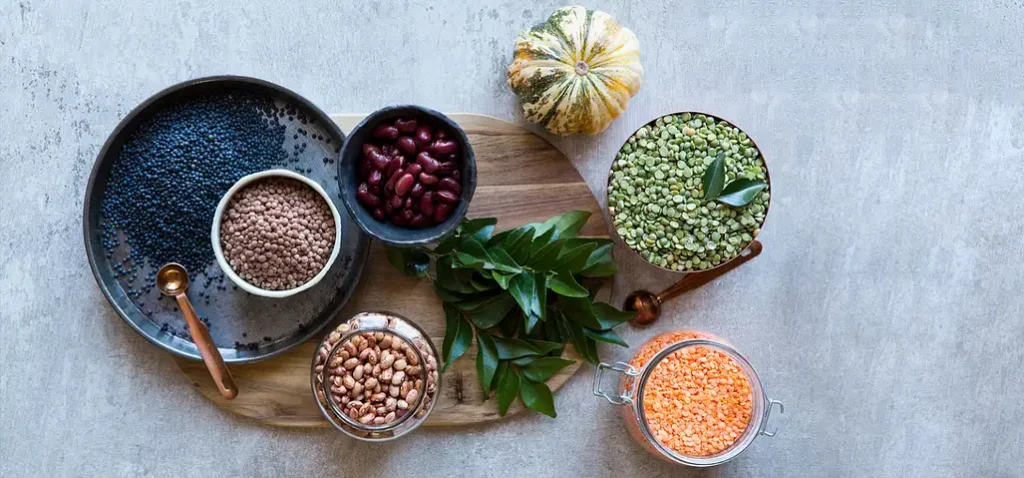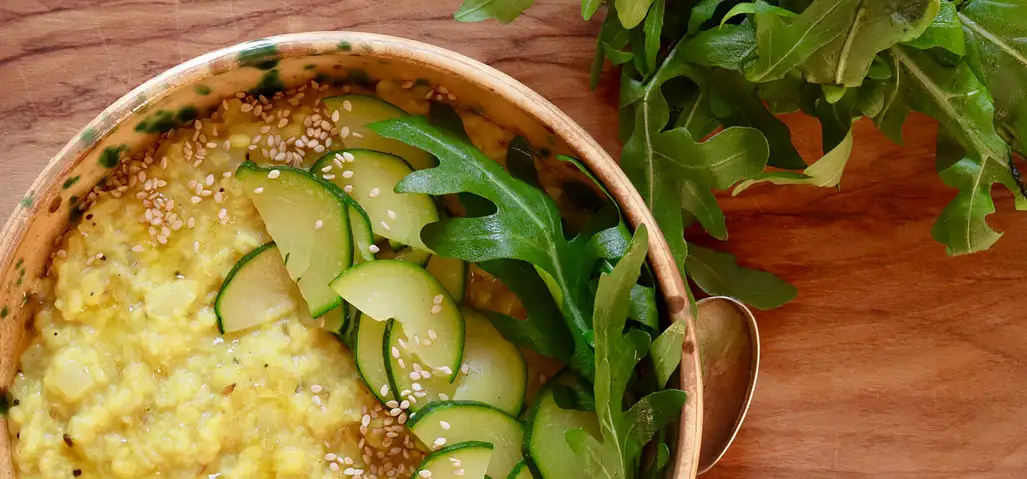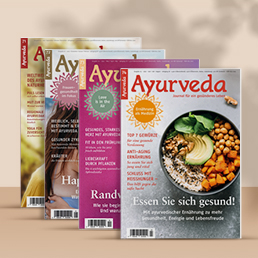Kitchari is a dish from Ayurveda that has enjoyed increasing popularity in the West in recent years. The simple dish of rice and mung beans is said to have various healing effects, it is described as the detox dish par excellence and seems to occupy an enormously important place in Ayurveda. But is that really the case?
About the origin of Kitchari
The word kitchari [or khichdi or khichuṛī] is derived from the Sanskrit word khiccā, which is a dish made of rice and pulses. In India, kitchari is a dish that has been traditionally prepared in many regions for centuries. However, there are various regional differences to be noted. In Gujarat in northern India, kitchari is a staple, especially in rural areas, and is often served at the end of a meal, for example, while in Bengal it is often the centerpiece of the meal. In northern India, much long-grain rice is used and the dish is relatively airy, while in the south, short-grain rice varieties such as sona masoori are often used and kitchari is denser with a buttery and rich texture. In some regions it is eaten as breakfast and in others as dinner, with plenty of buttermilk served with it. Kitchari is thus an integral part of Indian food culture and quite popular as it is filling, inexpensive, easy to prepare and tasty. Kitchari is also used in traditional Ayurveda – how exactly it is classified and described and whether it can really be considered a detox dish is clarified in this article.
On the popularity of Kitchari in the West
The fact that Kitchari has boomed in recent years may have several reasons. Many modern Ayurvedic secondary texts describe kitchari as a detox dish, and in most Western continuing education courses kitchari is the first dish taught as part of Ayurvedic nutrition. In addition, many people have positive experiences with Kitchari. Compared to a typical Western diet with a high proportion of baked goods and animal products or a healthy but not constitutionally appropriate diet, Kitchari can be a real boon. The simple dish then relieves the digestive tract and leads to the harmonization of many processes, both physical and mental. Many people who have had such positive experiences with Kitchari want to share them – and in the meantime countless articles about Kitchari can be found on the Internet and the dish is described as the Ayuvedic Detox dish par excellence for every time of day and season. But what role does the dish really play in classical Ayurveda?
Properties and effect of mung beans and rice

Before we go into the effects of kitchari, we will first describe the properties and effects of each of the main ingredients of the dish.
Green mung bean
Sweet and astringent taste (rasa), drying and easily digestible properties (guṇa), cooling (virya), it has a pungent effect after digestion (vipāka), lowers kapha and pitta and does not increase vata or only slightly. Green mung beans have a nourishing effect, give strength, reduce fever and improve vision. Unlike other legumes, mung beans are hardly flatulent. Soups prepared from mung beans are light and considered grāhi, meaning they stimulate the appetite and aid digestion. They are recommended for a wide range of imbalances, such as loss of appetite, weakened digestion or hyperacidity, among others. A special feature of mung bean is that although it is drying and pungent and has a catabolic effect on the body, it is still nourishing and restorative due to its sweet taste. This makes it a special food.
Rice
Each type of rice has different properties. Red rice (Raktaśāli) is sweet, cooling, tonic and easily digestible, lowers all doshas and is recommended for regular consumption. The Ṣaṣṭikā-śāli rice variety is light, mild, and tonic, lowers all doshas, and is also emphasized. These two varieties are described as the best rice varieties. Sona Masoori is a good alternative available in many Indian grocery stores in this country. The rice has a lower starch content and is easier to digest. Overall, ripened, old rice is particularly easy to digest, while young and unripened rice is considered harder to digest and can be slimy. Unripe basmati rice is considered to be of lower quality. However, when properly prepared, the recommended rice varieties have the property of removing moisture from the body (viśada).
Nutritional evaluation of kitchari
Kitchari is also a dish that has a high nutritional value from a nutritional point of view:
100 g of the green mung bean provides 334 kcal of energy. It is rich in carbohydrates (56.7 g/100 g) and is a very good source of minerals such as potassium (843 mg/100 g), magnesium (127 mg/100 g), calcium (124 mg/100 g), phosphorus (326 mg/100 g) and iron (4.4 mg/100 g). Vitamins such as carotenoids, thiamine (vitamin B1), niacin (vitamin B3), riboflavin (vitamin B2), ascorbic acid (vitamin C) and folic acid are also found in mung beans. It is considered one of the best sources of protein and contains a number of essential amino acids such as arginine, histidine, lysine, tryptophan, phenylalanine, leucine, isoleucine, tyrosine, valine, threonine, cystine and methionine. Certain chemical components such as flavonoids, phenolic acids and organic acids isolated from mung beans in recent years support their health-promoting effects as described in the classics.
In the case of rice, a distinction can be made between brown rice or whole grain rice, parboiled rice and polished rice. While brown rice still contains almost all the nutrients, parboiled rice loses around 20% of the ingredients. Polished rice is the least valuable from a nutritional point of view – in Ayurveda it is considered easily digestible and is recommended for weak digestion. Rice is about 75-80% starch, 7-9% protein and 0.5-3% fat overall. However, it also contains minerals such as potassium, magnesium, iron and zinc.
Due to the combination of legume and grain, kitchari contains a full spectrum of amino acids and is a good source of vegetable protein.
References to Kitchari in the classical Ayurvedic texts
Kitchari is mentioned in several of the classical texts of Ayurveda and is referred to as Kṛśarā. In the Caraka Saṃhitā and Suśruta Saṃhitā, for example, the dish is mentioned in a few places and a full description is given by the author Bhāvamiśra in his work Bhāvaprakāśa:
तण्डुला दालिसंमिश्रा लवणार्द्रकहिङ्गुभिः | संयुक्ताः सलिले सिद्धाः कृसरा कथिता बुधैः || कृसरा शुक्रला बल्या
गुरुः पित्तकफप्रदा | दुर्जरा बुद्धिविष्टम्भमलमूत्रकरी स्मृता ||
(Bhāvaprakāśa of Bhāvamiśra Volume 1, Chapter Kṛtānna varga).
This translates as: Rice is cooked with pulses and in water to form a porridge and then salt, ginger and hing are added. The dish is called Kṛśarā by the sages. Kṛśarā increases sperm, strength, is hard for digestion, increases pitta and kapha, is not easily digested, dulls the intellect, causes flatulence, and helps eliminate feces and urine.
In the Ayurvedic text Kṣēmakutūhalam, a specific recipe is even given. 12 parts rice is cooked with 8 parts mung beans in water and seasoned with ginger, hing, and turmeric that has been previously flavored in ghee. Again, kitchari is described as difficult to digest but very nourishing.
(Kṣēmakutūhalam of Kṣema Śarmā, chapter The Sixth Utsava).
Properties and effects of kitchari in the classical texts of Ayurveda.
Properties: Hard to digest, is digested slowly.
Effect: Nourishing and gives strength to the body if the person’s digestive power (agni) is strong enough for the digestion of kitchari; it increases śukradhātu (reproductive tissue) and contributes to stool formation, but may cause constipation.
Dosha: Lowers Vata, may increase Pitta and Kapha.
So is kitchari a detox dish?
According to the classical texts, kitchari is a good dish to strengthen the body, as it is said to be nourishing and restorative. However, this is only true on the condition that kitchari can be digested well. Thus, in case of pronounced digestive weakness or constipation, kitchari is not the right dish.
At this point, it should certainly be noted that easy or difficult to digest are characteristics that we must put in a comparison. Compared to a meat-heavy dish, kitchari is definitely an easily digestible alternative. However, in cases of illness or very weakened digestion, Ayurveda recommends varieties that are even easier to digest than kitchari, such as thin rice soup and mung broth or soup, among others. The weaker the agni, the higher the amount of water in these dishes, the stronger it becomes, the higher the amount of solid ingredients. Other ingredients, such as vegetables, seeds or many spices are then avoided – but this is only for a limited period of time until digestion becomes stronger again.
The fact that kitchari is not described as a detox dish and thus as purifying or cleansing may be due to the combination of mung beans with rice. The effect of food is altered by combination. Moreover, mostly rice does not have excretory properties but the opposite, is nourishing, and can be used as part of a restorative therapy (bṛṃhaṇa). Mung beans, on the other hand, do possess excretory properties and can be used as part of a reducing and purifying therapy (laṅghana and śodhana). However, because the rice content is relatively high and because of the combination of the two foods, kitchari is not actually considered a detox dish.
But if the digestion is strong enough and no indigestion is caused by kitchari, it can certainly be used to relieve the body and mind as part of a short course of treatment. Then Agni can become even stronger so that the body can discharge what could not be discharged before. However, depending on the constitution, other dishes can also achieve this effect.
CONCLUSION
The benefits of mung beans and the right rice in the appropriate preparation are manifold. And even though kitchari is not considered a purgative in itself, when prepared properly and adapted to the individual constitution and current condition, the dish can be part of a fasting and purgative regimen, helping to remove ama and excess doshas from the body. For this purpose, kitchari is prepared more like a soup, with the right spices and the appropriate ratio of mung beans and rice. While Panchakarma is the deepest form of purification, for many, a home regimen of kitchari provides a nice way to remove ama and break eating habits.

 © Ayus Publications
© Ayus Publications 












